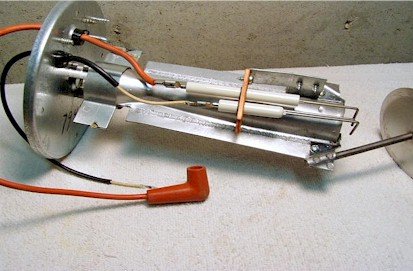Rusty_Recycled_Toy
Member
Ok, so this might be a no brainer for some of you, but it's bugging me.
I've been breathing some new life into this old '78 Itasca. It's time to tackle the furnace.
I took the unit ( Coleman ) out of the MH. Used compressed air to blow off the circuit board,clean out the fans,blow dirt dauber nests out of heat chamber.
Last week I installed the unit back into the MH. Hooked the wiring and gas line back up. Followed manufacturers start-up procedures to the letter.
Low and behold, as I watched through the sight glass the silly thing fired up. ;D
It started getting warmer and warmer. Then it went out. Then it lit back up.Then it went out, and didn't start back up.
I have repeated this scenario numerous times. It will light and burn for approx 1min. go out for about 10 seconds, light for 30 seconds,then go out.
What am I missing?
I've been reading some furnace posts and was thinking possibly the regulator? I mean sometimes 28 year old things get clogged/worn out.
When I light the burners on the stove, the more burners I have lit the 'better' the flames. With just one burner going it is almost like it is trying to blowitself out. Is this some indication that the regulator is malfunctioning?
So what would the general consensus be here? Bad regulator? Or do you think it is specifically furnace related?
Thanks,
Ed
I've been breathing some new life into this old '78 Itasca. It's time to tackle the furnace.
I took the unit ( Coleman ) out of the MH. Used compressed air to blow off the circuit board,clean out the fans,blow dirt dauber nests out of heat chamber.
Last week I installed the unit back into the MH. Hooked the wiring and gas line back up. Followed manufacturers start-up procedures to the letter.
Low and behold, as I watched through the sight glass the silly thing fired up. ;D
It started getting warmer and warmer. Then it went out. Then it lit back up.Then it went out, and didn't start back up.
I have repeated this scenario numerous times. It will light and burn for approx 1min. go out for about 10 seconds, light for 30 seconds,then go out.
What am I missing?
I've been reading some furnace posts and was thinking possibly the regulator? I mean sometimes 28 year old things get clogged/worn out.
When I light the burners on the stove, the more burners I have lit the 'better' the flames. With just one burner going it is almost like it is trying to blowitself out. Is this some indication that the regulator is malfunctioning?
So what would the general consensus be here? Bad regulator? Or do you think it is specifically furnace related?
Thanks,
Ed

